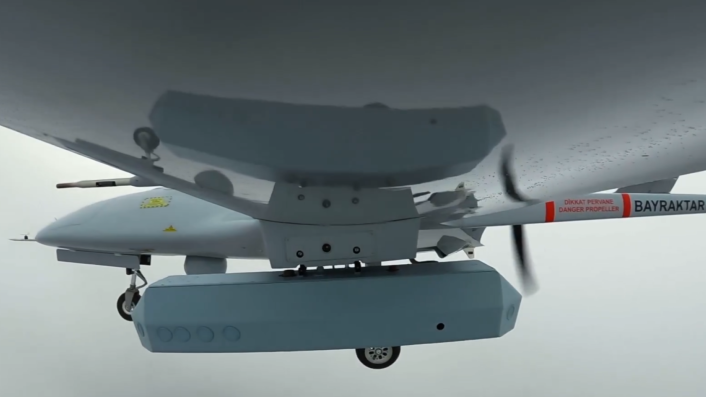The TB2T-AI has three new “AI computers,” a new turboprop engine and winglet. Recently, the TB2 also flew with the Antidot Electronic Warfare pods.
Turkey’s Baykar Tech, maker of the famous TB2 UCAV that saw extensive use by Ukraine in the initial months of the war with Russia and by several African and Arab nations, has unveiled its new variant called the Bayraktar TB2T-AI. Selçuk Bayraktar, the company’s Chief Technology Officer, released a video on Feb. 22, 2025, showing the first test flight of the drone, which is described as an Artificial Intelligence-enabled aircraft
Beside a new turboprop engine, the drone is distinguished by three new “AI computers” and new design configuration that has winglets on the wing and, interestingly, on the tail. The new power plant increases the MTOW (Maximum Take-Off Weight) and, consequently, the payload capacity. Also, the drone can now reach a speed of 300 km/hour and a service ceiling of over 30,000 feet.
New #BayraktarTB2T-AI ✈️🧠🚀
🚀 Turbo Engine
✅ New Aero Design
🧠 3 Advanced AI Computers
🏎 Speed: 160 kts (~300 km/h)
💪 Increased MTOW & Payload Capacity
☁️ Max. Altitude: 30,000ft++
⏱️ 30,000ft Climb: 25 min. #NationalTechnologyInitiative 🌍 pic.twitter.com/CdzdiRAACy
— Selçuk Bayraktar (@Selcuk) February 22, 2025
Meanwhile, the original TB2 UCAV also recently flew with an EW/ESM (Electronic Warfare/Support Measure) system made by Aselsan, completing its tests with the technology earlier this month. The pod is one of a three-pod system, called the Antidot 2, and specifically the Antidot 2-U/S. The other two are the Antidot 2-U LB/MB/HB (presumably standing for Low/Mid/High-Band) and the Antidot 2-U.

TB2T-AI
According to Ulusavunma, the TB2T-AI touched 30,000 feet in 30 minutes, which combined with the new AI capability, allows it to operate “more effectively and for longer periods of time in the combat environment.” The three AI computers provide autonomous flight, including “fully autonomous take-off and landing,” guided by “terrain referenced visual navigation,” where “visual recognition” is used to “identify runways.” It can also return to base automatically.
The AI technology also assists in resisting “challenging electronic warfare environments.” This particular feature can be said to have been motivated by the original TB2’s significant losses in Ukraine to Russia’s powerful EW capabilities, which also devastated Ukrainian battlefield communications and drone operations.
Bayraktar TB2T-AI first flight …@BaykarTech pic.twitter.com/GQi41CwZlB
— miguyan2000🚀🇹🇷 🇹🇷 (@miguyan2000) February 22, 2025
It is not known whether the TB2T-AI prototype that flew, T172, will be weaponized, but it is not unlikely either. It is also possible that the Turkish armed forces would be interested in replacing a majority, if not all, of their original TB2s with the TB2T-AIs.
TB2 Bayraktar with EW pods
While 2-U/S pod is used for ELINT (Electronic Intelligence) purposes to identify, classify and record emissions, the 2-U is used to perform electronic attacks against both adversary air defense systems and incoming SAMs, protecting the drone and neighboring friendly assets. The Antidot 2-U LB/MB/HB has a mix of electronic attack and SPJ (Self-Protection Jamming) capabilities.
The pod featured in the video released by Baykar Tech on Jan. 7, 2025, is the Antidot 2-U/S, that ground crew installed on the hardpoint of the aircraft’s left wing. While the video shows the TB2 in the hangar with two pods, it is later shown taking off with only one under the left wing, which is the Antidot 2-U/S. The other pod seen on the ground appeared to possibly be the Antidot 2-U.
#BayraktarTB2 ✈️ 🚀
✅ ANTIDOT-2U/S Elektronik Destek Podu ile Uçuş Testi
✅ Flight Test With ANTIDOT-2U/S Electronic Support Pod#Baykar 🤝 @Aselsan#MilliTeknolojiHamlesi 🌍🇹🇷 pic.twitter.com/iTLiVm19Gg
— BAYKAR (@BaykarTech) January 7, 2025
The rest of the clip is in-flight footage from a camera under the left wing, showing the pod and the TB2 in flight. Baykar Tech this time did not specify how long the UCAV flew and at what altitudes. The company has not explicitly said whether the UCAV was flying with the EW pods for the first time, as it usually does for any maiden achievement with its drones. This might suggest the unmanned aircraft’s testing prototype has flown with the Antidot prior to this.
Antidot EW pod system
Both the pods are easily identifiable, with the Antidot 2-U/S being more trapezoidal in shape, while the Antidot 2-U LB/MB/HB is split into a rounded cylindrical front and a rectangular half. A graphic rendition from Aselsan, however, showed the 2-U pod under the left wing and the 2-U/S under the right wing.
It is not clear if this arrangement of the pod placement is the final configuration on the TB2 or whether the locations are interchangeable. Another pod, named Antidot 2-U, can be seen at an exhibition stall, but its functions are however not known.
According to defense webpages, the Antidot 2-U/S locates “the position of RF transmitting systems such as radar systems, communication systems, command and control stations and anti-aircraft missile systems.” The data is immediately sent to the ground control. The pod weighs 30 kg and has an operating power of 40 Watts.
Art of #ElectronicWarfare 🚫📡 — Türkiye’s #Aselsan #ANTIDOT mini pods give #drones like the legendary #BayraktarTB2 the ability to not only detect and avoid radars, but also actively blind them, disabling the enemy’s radar-guided #airdefense systems. 🇹🇷 pic.twitter.com/muuHi1frqH
— Turkish Century (@TurkishCentury) January 24, 2025
The Antidot 2-U LB/MB/HB meanwhile identifies threats and defends the drone and nearby aircraft against air defense as an“escort” jammer. It has “support and attack capabilities that can detect and neutralize air defense systems […] enabling UAVs to approach targets within munitions range undetected.”
The pod is easily compatible with UAVs that can fire MAM-L munitions and “offers flexible mounting options.” A single drone can also carry several pods. It weights 11 kg, operates at 380 W and is available in different versions (LB/MB/HB) for different threats.
The ANTIDOT 2-U too acts like an on-board self-protection jammer from SAM radars systems, using “charged electronic attack techniques to suppress and deceive air defense radars.” It has “high output power, wide frequency and angle coverage.” The pod weighs only 45 kg and needs 1100 W of power, and can be installed in tactical class UAVs without converting them into special aircraft, thus enhancing their capabilities.
{#ElektronikHarp}
Gök vatanın koruyucularından güç birliği.
ANTIDOT 2-U/S:
✅Düşman radar sinyallerini algılıyor, kimliklendiriyor, kayda alıyor; hassas şekilde yön ve konum belirliyor.
ANTIDOT 2-U LB/MB/HB:
✅Küçük boyutu ve düşük ağırlığı, yüksek çıkış gücü ve çoklu hedef… pic.twitter.com/LC0uhMRm9C
— ASELSAN (@aselsan) January 24, 2025
Battlefield use
The TB2s initially saw success in Ukraine in the opening months of the war, before being lost in heavy numbers. However, radar and radio-frequency jamming UCAVs offer a different capability, especially when used in large numbers against the very medium, short-range and point-defense systems like the Tor and Pantsir that brought down the Bayraktars. Beside protecting itself and other friendly assets, it also threatens the enemy air defense crew of revealing their own location to Antidot-armed Bayraktar TB2s, which can cue radar-killing missiles.
If the AD crew decides to keep their radars off or make a limited use, the pod nevertheless constrains ground-based air defense, with the classic SEAD/DEAD (Suppression/Destruction of Enemy Air Defense) opening up radar-free corridors, and allowing other synchronized strikes. This is also similar to how Ukraine used coordinated ADM-160 MALD and British-French Storm Shadow/SCALP-EG strikes on Russia in mid to late 2023.

It has not been officially explicitly mentioned whether the Antidot pods are also compatible with other UCAVs like the Akinci or the TB3. However, a banner at the ADEX 2024 exhibition has shown Antidot pods under concept renditions of the TB2, Aksungur and the Akinci UCAVs. The possibility of the pods being mounted on future iterations of the Hurjet, the T129 ATAK light-class attack helicopter or the T929 ATAK 2 heavy-class helicopter gunship also cannot be discounted.

While the finer technical details of the Antidot pods are not known, a memory data bank system for both uploading and downloading the collected frequencies for analysis, can be assumed to be one of the features.









